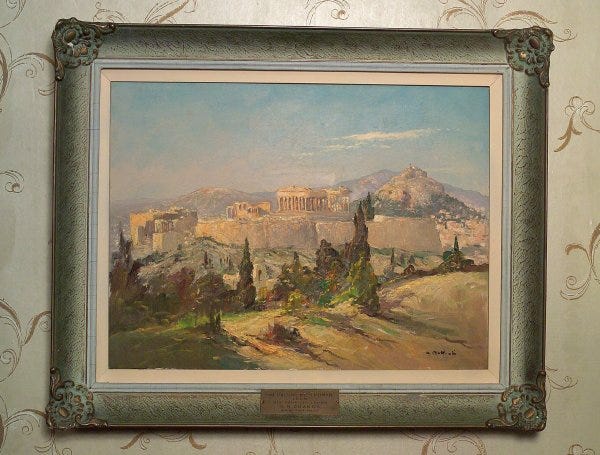
Thanks to members of Fayetteville’s Greek community, the U.S. Embassy in Greece is one step closer to solving a little mystery.
The mystery involves a painting of the Acropolis that hangs in President Harry S. Truman’s home in Independence, Missouri. A small plaque on the frame indicates that the painting was a gift in 1954 “To President Truman from his faithful friend, GN Drakos.”
Mark Marrano, consul general of the U.S. Embassy in Athens, Greece, was introduced to the painting by a curator at the Truman Museum. The subject of the painting came up as the two discussed a statue of Truman that stands in Athens.
Marrano hoped that members of Fayetteville’s Greek community might have clues about Mr. Drakos and why he sent the painting to Truman. By the way, Drakos is a shortened version of the name Drakulakos.
Marrano initially thought that Drakos was from Evrytania, in central Greece, but has since decided that he may have been from the Peloponnese, in southern Greece.
“From what our local staff told me, names ending in ‘akos’ usually come from the Peloponnese, from the Mani Peninsula,” Marrano said. “Names ending in ‘akis’ usually come from Crete. Since George N. Drakos shortened his name from ‘Drakulakos,’ this tends to make sense.
The name brought to mind many members of Fayetteville’s Greek community. Dina Goodson is a close friend of John Castanes, whose late wife Helen’s maiden name was Drakulakos.
“Mr. Castanes is an extremely interesting person, very intelligent, who has great stories and a great sense of humor,” Goodson said, suggesting that Castanes might have useful information.
Castanes and his son Chris, a Fayetteville native who now lives in Myrtle Beach, South Carolina, both did their best to determine whether their relative was the man who sent the painting.
It seems so.
“My father, Alexander Nicholas Drakulakos, was George’s brother,” John Castanes’ niece, Angela Drakulakos, wrote in an email to an embassy official about the painting. “All three brothers, Fotios, George and Alex and my grandfather Nicholas, were Ahepans (American Hellenic Educational Progressive Association) of High Point in the 1950s.”
It turns out that George Drakulakos served in the U.S. Army and was a fierce defender of his adopted country.
Alas, no one seems to know what motivated Drakulakos to send the painting to Truman.
But the president appreciated the gesture enough to hang the painting and send Drakulakos a thank you note.
“While we are still unclear about the motivation behind the donation to President Truman, at least we have identified the true donor and his next of kin,” Marrano said. “Since 1985, when the Truman House was turned into a museum, the painting had been misattributed.
Community News Editor Kim Hasty can be reached at hastyk@fayobserver.com or 486-3591.


